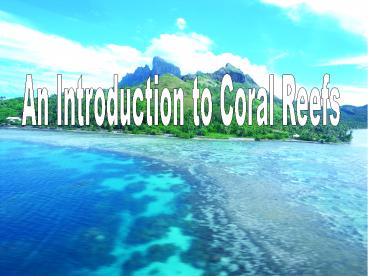An Introduction to Coral Reefs PowerPoint PPT Presentation
Title: An Introduction to Coral Reefs
1
An Introduction to Coral Reefs
2
What is coral?
- Its a living organism!
- It is an invertebrate
- 2 different types
- Reef Building Hermatypic
- Solitary Ahermatypic
- Coral is cousins to jellyfish and anemones
(Cnidarians) - Today we will talk mainly about reef building
coral
Sun Coral Polyps
3
Where Can You Find Coral Reefs?
- Coral is found all over the world
- Tropical
- Temperate
- Polar
- Only tropical corals build reefs
Coral reefs around the world
4
Coral Builds Reefs?
- The animal portion of the reef is called a polyp
- The polyp absorbs calcium carbonate out of the
water - The calcium carbonate is used to build the reef
5
Reefs Corals Build
- Corals can build three types of reefs
- Fringing grows close to shore
- Barrier also grows close to shore but has a
lagoon separating it from the shore - Atoll a ring of coral that surrounds a lagoon,
often grows on a submerged mountain or volcano
http//www.nos.noaa.gov/education/kits/ corals/med
ia/coral04a_240.jpg
6
Coral are Cnidarians
- Soft bodied
- Carnivorous
- Stinging tentacles arranged in a circle around
their mouth - Body symmetry
- Specialized tissues
7
Cnidarians
- Usually two life stages
- Polyp
- Medusa
- Gastrovascular cavity
- Food is broken down here but digested
intracellularly
8
Cnidarians
- Respiration and waste removal takes place through
body walls - Nerve net
- Some have a hydrostatic skeleton
- Some move through jet propulsion
9
Anatomy of Coral
- The coral polyps build a calcium carbonate cup
called a corallite to live in - Coral has stinging cells called nematocysts
10
Stinging Cells
- Nematocysts help coral catch food
- They also help protect the coral
- When the cell is stimulated, it releases a sharp
barb - The barb will fire and catch the food and bring
it back towards the mouth
11
Coral and Zooxanthella
- Symbiotic relationship
- Zooxanthella is an algae that lives in the skin
of coral - Coral provides protection
- Zooxanthella provides food and color!
12
Coral is Picky
- Very specific habitats
- Temperature 73-75?F
- Depth Less than 80 ft to 230 feet
- Salinity Normal salt levels (35ppt)
- Light Zooxanthellae need light to survive
- Sedimentation Being covered with silt interferes
with photosynthesis - Desiccation being exposed to air. The corals
will die if exposed too long
- Coral likes areas with lots of waves
- They are strong enough to withstand the pressure
- Freshwater means more food
- Waves remove silt
- New water brings more oxygen
13
Asexual Reproduction
- To reproduce coral can reproduce asexually or
sexually - Asexual reproduction in corals is called budding
- A baby polyp will begin growing off the adult
- When it is ready it will detach and live on its
own - This can not start new colonies, only help the
old colony grow bigger
This is a hydra (cousin to coral) with two buds.
One bud (on the right) is older than the other.
14
Coral Reproduction
- Sexual reproduction is called spawning
- External fertilization
- It can start new colonies
- Sperm and eggs are released into the water column
- The fertilized egg is then called a planula
- The planula swims until it finds a good place to
live
15
A New Home
- Corals now have a choice of where to live
- Corals are very sensitive and are rapidly dying
- People are trying to help by creating artificial
reefs
16
Arguments for Artificial Reefs
- It can help build or rebuild a reef
- It will increase fish populations by making new
habitats
17
Arguments Against Artificial Reefs
- Moveable
- Chemical leaking and leaching into the ocean
- It does not increase fish populations but rather
moves them to one location away from their
natural habitat which makes them easier to catch
18
Reefs in North Carolina
- North Carolina has reefs too!
- They similar to tropical reefs
- Reef fish swept up on the Gulf Stream live here
until winter - River beds that were covered when sea levels rose
- Also made up of
- Low rock ridges
- Outcroppings
- Coral patches
- Ship wrecks

